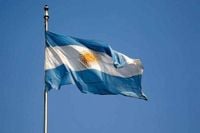Argentina’s economic saga took a dramatic turn this week as the country’s central bank signed a $20 billion currency stabilization agreement with the U.S. Treasury Department, in a bid to steady the beleaguered peso and reassure jittery markets ahead of a pivotal midterm legislative election. The deal, confirmed on October 21, 2025, arrives just days before Argentines head to the polls on October 26, with President Javier Milei’s pro-business government under mounting pressure to stem financial chaos and restore investor confidence.
According to Bloomberg, U.S. Treasury Secretary Scott Bessent described the pact as a cornerstone of a broader rescue package for Argentina, reflecting Washington’s “whatever-it-takes” approach to stabilizing South America’s second-largest economy. The agreement establishes the terms for bilateral currency swap transactions, giving Argentina’s central bank access to much-needed U.S. dollars as reserves dwindle and the peso sinks to historic lows.
But if the goal was immediate relief, the results have been underwhelming. Despite the headline-grabbing deal, Argentina’s peso continued its downward spiral, hitting a record intraday low of 1,476 per dollar on October 20 before recovering slightly, as reported by the Financial Times. This marked a level even lower than before the U.S. Treasury began buying pesos earlier in the month—a clear sign that Washington’s intervention, including an estimated $400 million in peso purchases since October 9, has yet to stem the tide of selling.
Market sentiment remains fragile. Argentine bonds, which initially rallied on news of the U.S. support, quickly erased those gains and remain well below levels seen after the first signs of American intervention. The country’s benchmark S&P MERVAL Index managed a modest 0.8% uptick, while the Global X MSCI Argentina ETF rose about 0.2%, according to Pantheon Macroeconomics. Yet, this was little comfort as the broader Latin American markets retreated—MSCI’s index of regional equities fell 1% on October 21, and currencies slipped 0.2% as the dollar strengthened globally, Reuters reported.
“The upcoming elections have kept investors defensive and liquidity thin; the market is largely in wait-and-see mode,” said Andres Abadia of Pantheon Macro. The uncertainty is palpable, with traders and locals alike bracing for further turbulence. Offshore contracts known as non-deliverable forwards now price the peso below 1,600 per dollar before year’s end, reflecting widespread expectations of continued depreciation.
President Milei’s government, which has championed pro-market reforms and closer ties with the U.S., faces a daunting challenge. The central bank’s reserves have fallen below $5 billion, excluding liabilities—a dangerously low buffer, according to the Romano Group, an Argentine consultancy. “Dollar demand has been very strong and is going to continue that way until we have the election results and more clarity on the exchange rate,” Salvador Vitelli, the group’s head of research, told reporters.
The political stakes are high. U.S. President Donald Trump, who has cultivated a close relationship with Milei, reportedly warned that he would pull the deal if Milei’s bloc fails to win Sunday’s midterm elections, as noted by Pantheon Macroeconomics. The message is clear: Washington’s support is conditional, and any hint of political instability could jeopardize the fragile lifeline.
In the meantime, the U.S. Treasury is not acting alone. Secretary Bessent revealed that he is coordinating another facility, also worth $20 billion, to be financed by banks and private institutions. This would double the available support, though details remain scarce and markets are still waiting for concrete terms.
Adding to the complexity, the International Monetary Fund (IMF) reached a preliminary agreement with Argentina in April for a $20 billion bailout, but the final outcome hinges on the results of this weekend’s election. Both the IMF and U.S. Treasury are expected to press Argentina to rebuild its reserves after the vote as part of a new agreement, according to Abadia.
Despite the gloom, there are a few glimmers of hope. Inflation, long a scourge of Argentina’s economy, cooled slightly in September: the consumer price index rose 2.1% month-over-month, bringing the annual rate down to 31.8% from 33.6%. Core prices increased 1.9%, aided by tighter fiscal and monetary policy, though real wages, employment growth, and consumption remain stubbornly weak. Pantheon Macro expects inflation to end the year near 30%—a “good” outcome, given the recent turbulence.
Still, the challenges are formidable. “Depreciation pressure will persist in the near term. Both the IMF and the U.S. Treasury are expected to push Argentina to rebuild its reserves after the elections as part of a new agreement,” Abadia predicted. “Whether this time will be different remains uncertain; Argentina’s long record of defaults and dependence on foreign financing argues for caution.”
The broader context isn’t much rosier. Latin American markets have been hit by falling commodity prices, with Chile’s IPSA index down 0.5% and Peru’s Lima Stock Exchange suffering its biggest intraday drop since April, according to Reuters. Brazil’s Ibovespa index fell 0.4%, and the real weakened 0.2%. Argentina’s stocks (IMV) fell for the second straight day, down 1.2% ahead of the elections, and the peso closed at a record low on October 20 before dropping another 1% on October 21—its sixth consecutive session of decline.
Meanwhile, political developments across the region have kept investors on edge. Colombia and Argentina remain in focus, with Colombia’s foreign ministry working to heal a rift with the U.S. over drugs and tariffs. The episode, said Felipe Barragan of Pepperstone, “has reinforced perceptions of geopolitical risk at a delicate moment for Colombia’s economy—one heavily dependent on trade and remittances from the U.S.”
For Argentina, the immediate future hinges on Sunday’s vote. If Milei’s bloc prevails, analysts say it could anchor expectations, attract moderate allies, and make it easier to pass structural reforms, supporting a gradual economic upturn and stabilizing the peso. But if the results disappoint, public discontent and social unrest could flare, and the risk of a forced devaluation would rise sharply.
As the world watches, Argentina stands at a crossroads. The $20 billion U.S. lifeline has bought some time, but the real test—and the fate of one of Latin America’s most volatile economies—will be decided at the ballot box this weekend.


